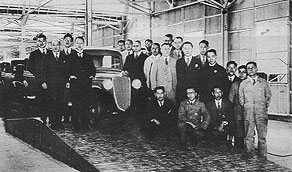 |
Birth of Nissan Jidosha (Nissan Motor)

Yoshisuke Aikawa was determined to mass produce passenger cars in Japan that could compete with American imports. Despite the fact that in early-Showa Japan the main demand was for military vehicles, he kept his sights firmly fixed on the distant future.
The Jidosha Seizo Company was registered in December 1993, and it took over the Tobata Casting Automobile Dept., together with its Osaka factory and all the assets and trading rights that went with it. The new company also acquired all of the production and distribution rights for the Datsun, which was later to become the flagship model for Nissan Motor.
In May 1934, at the company’s first ordinary general meeting of shareholders, Jidosha Seizo changed its name to Nissan Jidosha (Nissan Motor). At the same time, Nissan Sangyo was to take over all of the Nissan Jidosha shares held by Tobata Casting.
According to the statistical data for 1934, the bulk of the car supply in Japan that year was comprised of imports - either finished (896) or in knockdown form (33,458) - with domestically manufactured vehicles totaling just 2,247. That was why Aikawa (who concurrently served as President of Nissan Jidosha) made a momentous decision: "We need an annual output of 25,000 cars. Let’s say we make a 1,000 yen loss on each one; in that case, we must be prepared to chance a 25 million yen deficit. Really this is a burden the state should shoulder, but since it shows not the slightest sign of doing anything, I’ll do it." And with that he set his company on the road to mass production.
|
 |



The first Datsun (Type 14 sedan) rolls of the line at the Yokohama Plant on April 12, 1935. This factory was equipped with the latest production technologies, including the first belt conveyor to be installed in Japan. |
